As an arena for self-expression, Facebook enables all manner of intriguing displays of individuality. Beyond the basics--the lists of favorites and About Me section--there are also thousands of add-ons and applications to make one's profile unique. There is one part of the profile, however, that is often overlooked for its potential for distinguishing oneself. For most people the answer to "religion" is a simple encyclopedic response, such as "Baptist" or "Jewish-Reform." But being part of the generation of customization, many on Facebook have taken to classifying their religion more loosely and personally. Consider the following:
Jesus is my superhero.
In Christ alone my hope is found.
follower of Jesus
jesus saves me every day
Jesus, Mary, Joseph and a camel... I'm Christian!
I find these declarations of faith quite interesting, and have started collecting new examples that I come across. Please submit any you find in the comments!
Keep reading...
Monday, December 29, 2008
Christian Creativity
Saturday, December 27, 2008
Fascinating

In book design, as with many things in life, simplicity is better. With hundreds of thousands of books released each year, publishers must make their titles stand out and communicate to prospective buyers instantly. Sometimes this is as simple as featuring the author’s name big and bold (John Grisham, Sue Grafton, etc.), and sometimes it is with a straightforward photo or illustration.
And many times it is the title. Titles can be mysterious or informative, plain or controversial, but one rule is common across genres and designs: rarely the title more than four or five words. Many times, in fact, it is far less: one word. A title should be memorable, easy to recommend or request as a gift. A title strives to be as short as possible, without becoming generic. If it sounds generic (House, Baseball, etc.) the design must step up to make it stand out.
There is a part of the bookstore that trades in these catchy one-word titles more than any other: the history section. Here a browser can find all sorts of intriguing titles—for example Coal, Wood, Drink, Salt, and Cod. Each of these books takes a single subject and explores its place in history. The appeal lies in the magnification of a seemingly mundane object and its concomitant contextualization in the grand story of human history. This naming technique could theoretically be almost infinitely adapted : War, Computer, Book, etc., simply by distilling an otherwise obscure or complicated matter into a neatly defined title. This makes the book appear to be the definitive source on the subject at hand, a must-read for anyone with an interest in that topic.
As a bibliophile myself, I am consistently drawn in by books like Cod and Wood. I may not have cared a whit about Cod before, but seeing an entire book written about its significance suddenly makes me very curious. Reading books like these enables one to experience history from a new perspective. Rather than reading a linear account of 18th century European commerce, one sees the role that the cod trade played in this story. It’s a fascinating and enjoyable way to digest potentially dry facts and events, and a niche genre of non-fiction I highly recommend.
Keep reading...
Thursday, December 25, 2008
The Roller Coaster That is Sports Stardom

Walking through the mall a few weeks ago, I saw that a group of football players from my (SEC) alma mater were signing autographs outside one of the department stores. I had had a class with one of them, and decided to stop by and say hi since I hadn’t seen him in a while.
He sat at a table with four other former Division I stars, all dressed in their jerseys and looking as strong and fit as ever. Several of them had been drafted in late rounds by NFL teams, but none of them had managed to make the final cut. When I asked my friend what he was up to, he told me he was living at home and looking for a job.
This confession startled me, but also brought me to an important realization. This football star, a big man on campus only 18 months ago, and briefly a member of an NFL team, was now in (nearly) the same situation I was. (I have a job.)
I realized there must be thousands of Tonys out there, athletes on the brink of making it big, but who fall just short. Athletes who excel in competitive NCAA Division I sports, but are not quite good enough to get paid to play. It must be incredibly crushing to the self-esteem of an athlete who has dominated for so long to be so close to his lifelong dream, and yet unable to go all the way. To be in the top .01% of one’s sport, but due to a bad combine or an inopportune slump failing to get that million-dollar contract that the guy next to you gets.
Many of these millions of near-pro athletes find themselves returning to regular life without having developed other vocational skills, devoting themselves in college instead to their athletic career. Furthermore, they likely suffer to some degree from depression, haunted by what-ifs and denial. To be thisclose to stardom, mansions, Ferraris, and rings and then a week later be living with Mom is not an easy situation to come to terms with.
There’s not much I can do to help console them, as I am incapable of fully empathizing with them, but I feel the NCAA must do what it can to reach out to those who dedicated themselves to collegiate athletics, with the dream of playing professionally, only to find themselves just shy of that goal. Hopefully the NCAA already does this—tries to help its graduates find work and fulfillment—for their success outside of athletics is crucial to our success as a sports-loving society.
Keep reading...
Tuesday, December 23, 2008
Screengrab-o-rama
Here are some interesting/funny/weird screengrabs I've taken recently.
Adding "http://bacolicio.us/" onto the beginning of a URL will add a thick slice of bacon to the page. Try it for yourself!
I came across this online hangman game today while doing research at work. I consider myself pretty good at geography, but this one stumped me completely. 
One day last week on YouTube 17 out of the top 20 most-viewed videos were of the Bush shoe attack. 
A few days ago I tried to access FinalCrit.com, a site where I have my advertising portfolio posted, but the site seemed to be dead. This is what showed up in Google when you searched for it.  Keep reading...
Keep reading...
Saturday, December 13, 2008
If Beyonce's Stylist Died in the Forest and No One Heard...

This past week, two relatives of celebrities met their demise: Mark Ruffalo’s brother in an apparent Russian roulette accident in an apparent homicide and Macaulay Culkin’s sister in a car accident. Both of these events appeared in the breaking news headlines on websites and news channels, and will soon be buried by newer occasions of sensational celebrity news.
I would understand if Ruffalo or Culkin themselves died, but their siblings were hardly public figures. Is being related to a famous person really enough to qualify for headline-news status? And if so, where does it end? First cousin? Second cousin? Second cousin thrice removed? The line is blurry, and, more to the point, silly to try to determine. People like Scott Ruffalo and Dakota Culkin deserve an obituary like anyone else, but not 20% of the headline space on the Yahoo home page. Their passings are private matters, and should not be covered this intensely unless they actually affect the public in some way.
Interestingly, the online Times of London article about Culkin’s sister devoted the majority its words to a brief history of Culkin’s career and life. Clearly the paparazzi hardly even care about her sister; her death is only an excuse for a filler item about her brother, the troubled child star.
I’m not the first person to criticize the 24-hour news machine, and I won’t be the last. But I feel strongly that our journalists should do a better job of censoring the information they feel is newsworthy, and concentrate more on topics of actual importance to the society they serve.
Keep reading...
Thursday, December 11, 2008
Censoring One's Life Based on Fun
Generally speaking, there are two types of things we do our leisure time. Things we do because we want to, and things we do because we feel we should. There is a psychological tendency to view activities that are unpleasant as beneficial to one’s mastery of self, building character and self-discipline. When we ache after a workout we feel as if it was a “good” workout. When we leave an art film confused and perhaps disturbed, we feel as though we have just witnessed “real” cinema.
For me, two examples of this are swimming and reading classic works of fiction. I see my continued partaking of these activities as positive in several respects. Swimming is a pretty useful skill, as far as sporting abilities go. It’s certainly better to know how to swim than to serve a tennis ball. So although one lap leaves me huffing and puffing, and despite the fact that my goggles never stay on right and I have to constantly adjust them to keep water from getting in, I keep on swimming. I don’t enjoy it. I may even hate it. But I do it anyway, hoping to get better (which I never do).
Same with reading classic fiction. Do I like reading dense paragraphs of Victorian English whose plots leave me utterly bored and sleepy? Not at all. I’d much rather read some stimulating modern fiction (although I still read exclusively “literature,” rather than popular fiction, which I avoid due to its lack of perceived edifying content). Yet I continue to plod through Faulkner, Dreiser, and others, believing I am bettering myself by perfunctorily running my blurry eyes over the words on the pages.
I’d love to be able to say, “Clearly no one should do something they don’t enjoy. We have very limited free time, and you should spend it doing something that is fun for you.” But despite this logic, a large part of me still strongly insists that life is made richer by forcing yourself to swim, to eat new foods, to listen to music that you don’t usually like, etc. Life is about more than pleasure; it is about learning. If we cherry-pick the things we do and never challenge ourselves to push through unpleasant times, we are guaranteed to lead sterile and static, albeit fun, lives. The choice is ours.
Keep reading...
Wednesday, December 10, 2008
Post #100! Interesting Pictures

Yes, the nation of Turkey does indeed have a city called "Batman." It's located in the Kurdish Southeast, and over a quarter-million people live there.

Thanks to Wikipedia for this picture and caption, found in the "Sock" article.
Keep reading...
Monday, December 1, 2008
Cool Sites of The Day
 |  |
This site shows how with expert make-up and photography, a model can look 10 years old or 60. Amazing.
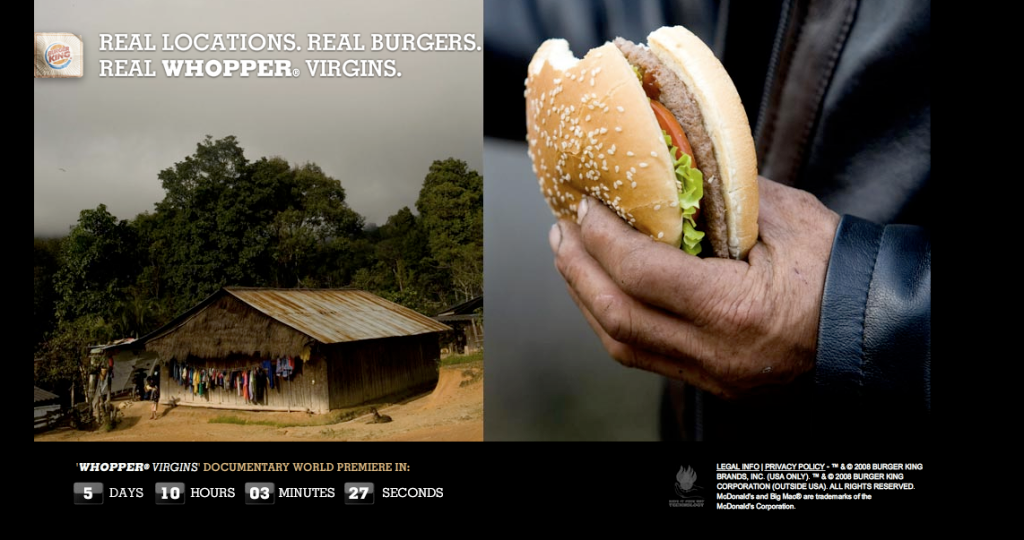
Crispin's new work for Burger King is obvious, but genius. They took a film crew to Thailand, Romania, and Greenland, and gave Whoppers to people who were totally unfamiliar with the product. Enter: Whopper Virgins. Videos will be posted later this week on the site. Keep reading...
Friday, November 21, 2008
WTF Underwear

Have you ever bought a pair of underwear and thought to yourself, "Dang, these underwear would be perfect, if only they had a pocket for my iPod!" Well, to all you modern-day Joel Goodsens out there, you're in luck. Play Underwear offers something called the "iBoxer," an MP3 compatible pair of boxer briefs for men and women. I know companies feel the need to make everything "wired," but isn't this taking it a little far? It almost seems like a product there would be a fake commercial for on SNL...
Keep reading...
Monday, November 17, 2008
Cool Sites of The Day

Sprint has just released one of the coolest websites I've seen in a while. The main concept behind the site is "Now." Basically the page is a bunch of simple widgets that represent "now" in various ways, from scrolling counters of various items to live video, to interactive games. There's also a futuristic female voice who intones statistics and clever statements every few seconds or so. Definitely a site to check out. Incidentally, I've noticed that several sites recently have used as background noise a low-pitched hum, possibly recorded from an aircraft flying overhead. I'm more of a visual than sound designer, but perhaps this sound is the equivalent of a plain black background on a
webpage. 
Addictomatic is a cool new search engine that simultaneously searches a bunch of different social media sites for the most current web activity on a given topic. Drawing from a variety of sites seems to be the new trend in online search (see also 123people.com). Perhaps Google should get on this boat. It's definitely a much better reflection of today's internet than a single list of webpages.
Keep reading...
Cinematic rebirth
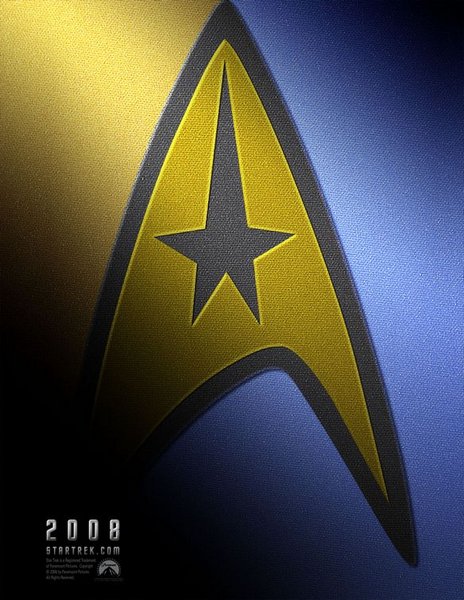
In advertising, it’s called rebranding. In showbiz, you can call it a good bet to make lots of money. The basic idea is to take something old and stale, and refresh it to make it popular once again. It’s worked wonders with brands like Tab and Cadillac, and filmmakers have recently adapted the concept to some of our most beloved TV and movie dynasties.
The first example was Batman Begins in 2006. The Batman series was struggling. It had gone from intentionally campy to almost serious to unintentionally campy, and audiences were not pleased. But put in the hands of a “serious” director like Christopher Nolan, and with some intense acting from Christian Bale (just realized both of the principals responsible for this cinematic resurrection have “Christ” in their names), the character was reborn and the soul of this American comic classic revived.
It happened again with Casino Royale in the same year. Writer Paul Haggis and director Martin Campbell rewound the clock on the timeless Bond character, effectively rebooting the story of the debonair British spy. They made Bond more physical (though less sexual), more brooding, and more rugged. The film was less about puns and cheap laughs than a study in cold and efficient espionage.
Both of these films were extremely successful financially, and were followed by equally successful sequels this year. This, too, ran counter to the history of both series; normally each sequential movie was not a direct chronological follow-up to its predecessor, but rather an altogether new story. Next year another landmark series will be reborn on the big screen, namely Star Trek. In the able hands of J.J. Abrams, it will follow James Kirk from boy to captain of the Enterprise. This film, like the others above, must strike a balance between presenting a whole new vision of the story, while also maintaining a visual and narrative link to the past.
No matter what, this return to “seriousness” (possibly mirroring the similar change in politics) is a welcome improvement. With a view to the long term development of the character, rather than an individual blockbuster movie, the studio ends up instead with a succession of blockbuster movies.
Keep reading...
Thursday, November 13, 2008
Piperlime: A brand I love
Searching online recently for the best price on a pair of Tom’s shoes, I came across a site called Piperlime. I noticed that the site was connected to the websites of the Gap and Banana Republic, which turned out to be because all three are owned by the same parent company. This came as a surprise to me; I had no idea the Gap operated an e-commerce site that sold other brands of footwear and accessories.
The Piperlime site itself had an excellent, intuitive interface. A variety of pictures from different angles were available for each shoe, all of which could be zoomed in on with no loss in picture quality. I was sold. But before confirming my order, I did a quick search on Slickdeals.net to see if any coupons were available for Piperlime. And indeed there were; just like that, I got an extra 20% off my purchase. Between the coupon and Piperlime’s free shipping (and free return shipping, if necessary) I spent only $28 and change for the shoes, which cost at least $8 more on other websites. Within minutes I had an email confirmation of my order.
A couple days later, I got another email announcing that my shoes had been shipped, and would arrive in 4-9 business days. To my surprise, they arrived the next day. Inside the box, I found the Tom’s box, wrapped in tissue paper fastened with a Piperlime logo sticker. The interior of the shipping box itself was decorated with a pattern of Piperlime logos, and all the paperwork was tucked neatly into a small green folder made of cardstock. A note from Piperlime thanked me for my purchase, and instructed me how to use the return shipping label if I wasn’t satisfied.
From top to bottom, I was completely blown away by my shopping experience with Piperlime. From the cheery name and logo to the consistent brand identity throughout all consumer touchpoints, Piperlime does everything right. They make the buyer feel happy and appreciated, setting the stage for future purchases. In an era in which customer service is all but dead, it’s great to see a company that takes it so seriously.
Keep reading...
Tuesday, November 4, 2008
Facebook and Election 2008

When voters went to the polls in 2004, Facebook was still in its infancy. Created in the spring of that year exclusively for Ivy League students, the website was only beginning to spread to larger state universities. High school students were still more than a year away, and the controversial opening to everyone in the world wouldn’t come until late 2006. The role it played in the ’04 election was minimal, for several reasons. Externally, John Kerry was just not as exciting to young voters as Barack Obama. He failed to energize the Facebook generation, and subsequently lost the election. Obama, however, has great appeal to the young and tech-savvy; his youth and composure, his photogenic family, as well as his outstanding personal branding campaign have all contributed to his popularity among a typically-apathetic voting bloc.
Internally, the site itself has evolved immensely, having added many features and undergone numerous changes that have turned it into the world’s most popular social networking site. Status updates, or microblogging, is now an extremely common way of communicating with one’s friends. Users update their Facebook (as well as their Twitter, Gmail, etc.) status with surprising frequency. Though I do not have statistics to support this theory, I would guess the amount of status updates today surpasses that of any previous day. Everyone is weighing in on the election, from proclaiming their political allegiance to decrying the drawn-out campaign. Through the “Causes” application, the site even allows users to donate their status, either in support of a particular candidate, or just to encourage voting.
Beyond the enthusiasm of its community, Facebook offers several applications or tools that allow its users to express their political voice. Within the popular “Gifts” app, one can post buttons to friends’ profiles. These icons normally cost $1, but the special election buttons are free. (The Obama buttons, tellingly, perhaps, are somehow sold out.) Additionally, the site has designed an entire election page, complete with a running counter of Facebookers who have voted and a tool for finding your polling place.
It’s exciting to see a site to central to the daily lives of millions of people playing such an active role in one of the most important elections in decades. Facebook is remaining nonpartisan, merely serving as a resource and gathering place for the hoards of election-hungry news junkies. Politics has gone social, and the world is the better for it.
Keep reading...
Absentee Voting Is Awesome

(Thanks to Zlatko Unger for the sweet photo)
Along with an unprecedented number of other excited citizens, I recently voted with an absentee ballot for the first time (OK, it was only the second presidential election in which I’d been eligible to vote). Nonetheless, the beauty of the absentee ballot was quickly apparent to me. In fact, this type of voting offers so many benefits over traditional polling-place voting, that I believe it should become the standard. Let me explain.
First, the obvious: convenience. The ballot comes to you. No waiting in long lines in the early morning. This inconvenience is a major deterrent for many dispassionate voters, who cannot be bothered to wake up early or take time off from work to head to the polls. Bring the ballot to the voter, and see turnout explode.
This convenience also has an important side benefit, the ability to learn about unknown candidates or referenda instead of casting a blind vote. There are many minor local races that fly under the radar of most voters, but being able to vote at home allows proactive citizens to research the issues online in order to make an informed decision. Thus absentee ballots make the election process both more rational, as well as less prone to common voter biases (first name on the ballot, cool-sounding name, etc.)
Some might argue that mailing tens of millions of ballots is bad for the environment, given the massive amounts of paper it would require. I argue the contrary. Most voters currently drive to the polls, generating large quantities of carbon dioxide, as well as clogging up traffic. Although paper requires energy and resources to produce, it can be recycled. Thus absentee voting is more environmentally friendly.
There is one final bonus to absentee voting: government revenue. Returning a ballot costs each voter about 60 cents, which, when multiplied, is tens of millions of dollars in revenue for the Post Office (suffering lately due to competition from email, as well as reduced quantities of junk mail and catalogs). The cost of a couple stamps is negligible, especially when compared to all the hours of productivity and pay lost when people miss work to vote.
Though it’s too late to vote absentee this year, I strongly encourage everyone to give it one more go at the polls before they close. But we can all hope for a more fair and effective voting process in the future.
Keep reading...
Monday, November 3, 2008
Poor Microsoft Banner Ad

I'll refrain from excoriating Microsoft and CPB for their utterly uncreative and boring television campaign, given the thousands of bloggers who have already done so weeks ago. But I would like to excoriate Microsoft and CPB for the banner currently running on the Yahoo home page. The ad is made up of a bunch of thumbnails of people's faces, and runs across the page. It's completely static, so it really doesn't grab your attention as a banner in that position should.
It's the copy, however, that really bothered me. I had to read the line three times to understand it, due to several copy flaws. First, it's set in all caps, which is generally hard to read. Second, they use an apostrophe to indicate the plural of "PC," which, while understandable, could have been made more legible by setting the "S" in small caps. Third is the confusion introduced by referring to "Real PCs" as "who." Given this pronoun, I assume they mean the people, rather than the PCs, but this conclusion is not an obvious one. Lastly is the phrase "got on TV." I tripped up over the final words twice, and I still am not sure I understand what they mean. In what respect did these people get on TV?
The only redeeming part about this ad is the interactivity of the banner. Each individual square picture is clickable (and programmed with their own rollover action). That's pretty cool, considering most Flash banners have only a handful of distinct clickable areas. The problem is, the payoff for clicking is unimpressive. Just a five second clip of the person saying, "I'm a PC, and I love ____." Booooring.
Keep reading...
Monday, October 27, 2008
Parsimony: Smart, not Semitic

As a member of a group with many entrenched stereotypes associated with it, I must always be on my guard, trying to ensure my actions aren’t confirming these potentially-pejorative beliefs, thus propagating them and reflecting negatively on the community to which I belong.
You see, I am Jewish. I’m not a religious person, but I am Jewish in the cultural sense (a refrain you’ll commonly hear among many modern Jews). The company I keep, however, aside from my family, is not Jewish. What’s more, I’ve been in many situations over the years in which I was actually the first Jewish person someone had ever met. Do I want to be their archetype for a Jewish person? Not at all. I am an individual like anyone else, and the decisions I make should not color someone’s perceptions of an entire population. Nonetheless, they do.
If I decline to buy a shirt because it’s not on sale? Jewish. Use coupons when eating out or going to the grocery store? Very Jewish. Pick up a coin on the ground? Jewish! Always order water at a restaurant instead of a drink? Totally Jewish. Now whenever I am in a situation that involves money, my brain does some automatic calculations to determine the consequences of my choices on others’ opinions of Jews.
Perhaps a quick summary of my financial situation will serve to illustrate another reason, beyond my religio-cultural upbringing, that influences my buying habits: Working for $12/hr, attending a school that costs me about $3000 per quarter, and sitting on a 40% loss in the value of my savings due to the stock market (I know, I know. Only a 23-year old Jew would have money in the stock market.) In short, I am not rich. It makes perfect financial sense to save money where I can. In a gentile’s shoes I am being frugal, which is an admirable quality in Christian theology. But as a Jew I am looked down upon, and chided for my thriftiness.
Perhaps due to our current economic crisis, parsimony will gradually attain the respect it had for much of the 20th century, until a culture of conspicuous consumption and buying on credit took over. For frugality should be considered a characteristic of all intelligent people, whether their last name is Stein or Stone. .
Keep reading...
Water Fountain Rule No. 1

If you are filling a water bottle, always use the shorter fountain.
Keep reading...
Thursday, October 23, 2008
Smart Excedrin YouTube Promotion
Excedrin Speed Gels has a YouTube page on which they feature various "fast" skills. A nice way to connect the product benefit to some user-generated content.
Keep reading...
Sunday, October 19, 2008
Finally, Another Cool Advertising Post
Honda turned a stretch of road in California into a musical instrument. By arranging grooves on the road in a certain order and pattern, the team created a road that played the William Tell Overture as cars drove over it. Neighbors complained soon enough about the noise, but the publicity from this singular, unexpected stunt surely makes up for it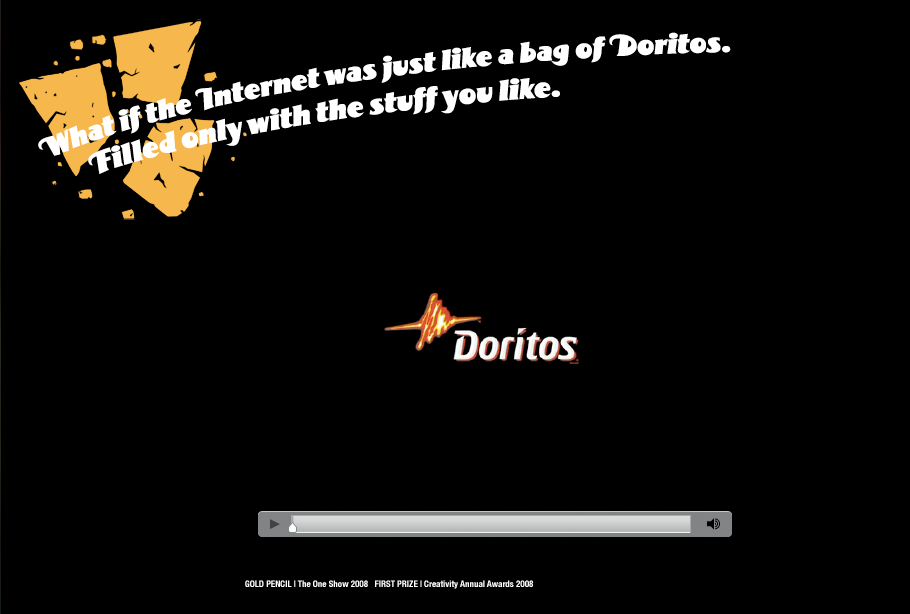
This is kind of old (it won a 2008 One Show Pencil), but I'm posting it anyway. An agency called Papercut in Sweden developed a fantastic digital campaign for Doritos that breaks through all the proverbial clutter--in fact, it does away with it altogether. By downloading an application to their desktops, users are able to replace the ads on a given webpage with whatever content they want.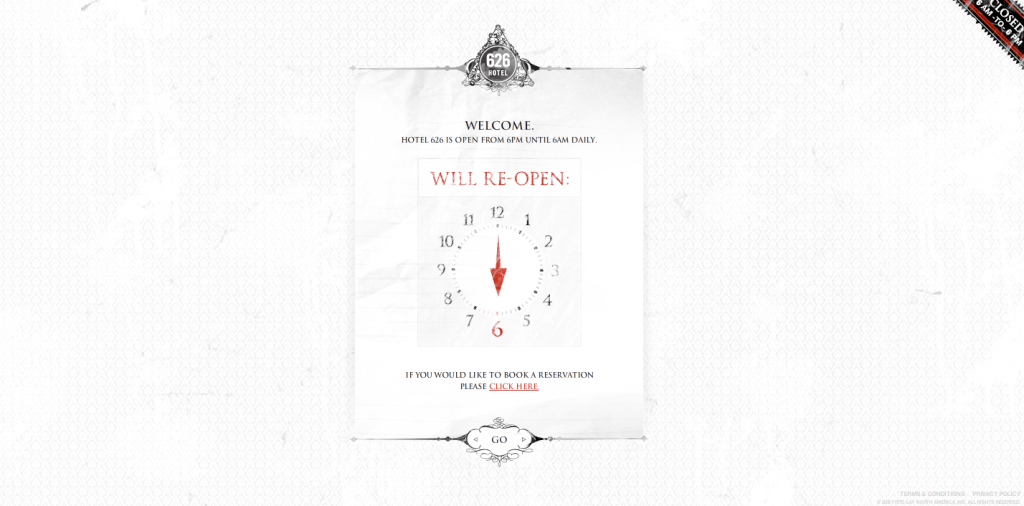
More recently, Doritos unveiled a microsite called Hotel 626 (by Goodby) that lets visitors explore 13 rooms of a haunted hotel and solve Myst-style puzzles and challenges. What's more, it's only open from 6pm-6am EST, to ensure people experience it in the proper mood.
Keep reading...
Thursday, October 16, 2008
Advice to Young Investors
The recent market crash has wiped out trillions of dollars in (paper) wealth, crippling consumer confidence and quite possibly tipping the upcoming election in favor of Barack Obama. Economists and journalists everywhere are weighing in on the situation, analyzing it from all possible angles and viewpoints—advice, reassurance, warning, criticism, etc.
As a young investor, I have a different perspective on the meltdown from most of these pundits. I’m not an expert, and I don’t presume to be able to talk intelligently about the complex web of financial blunders that led to the crisis. But I have learned a few lessons from the events of the past few weeks, lessons I hope others will take to heart as well.
I’ve been investing for about 10 years, ever since my Bar Mitzvah, which was the first time I had money to invest. Initially I invested only in small amounts, keeping most of my savings in a interest-bearing account at the bank. Gradually I put more and more money into the market, until about 90% of my savings were tied up in non-liquid assets.
This was mistake number 1. Balance is key. Stocks are volatile by nature, and even the most daring investor should reserve at least a quarter of his assets for conservative, liquid investments like CDs and bonds that are more resistant to economic downturns. My exposure to the dangerous swings of the stock market was far too great, and now I am suffering the consequences.
Lesson number 2: sometimes, it’s good to sell. Even a young investor should take a profit once in a while. Generally it’s good to think long term, but I took this good piece of advice too far. When the market was around 14,000 last summer, several of my investments were up 20-30%. Even though it’s impossible to know exactly when the market is peaking, history showed that a correction was coming. Rather than holding out for greater growth, I should have sold a portion of my gains, in order to secure some profit. Instead I watched as their values slid lower and lower, until they were worth half as much as I originally put in.
Conversely, you shouldn’t buy too soon. As the market declined, I kept feeling the urge to capitalize on the slide by buying stocks that had seen heavy losses. I’d see a stock nearing its 52-week low (Target, for instance) and think, “Gee, I’d better buy some of that before it turns around!” And I would, completely ignoring the fact that the market has been in a bull market for four years (meaning a 52-week low was really not a good indicator of its floor), so there was no good reason to think the stock wouldn’t drop right through its low. And it did. Target, Adobe, and Whole Foods were all stocks I bought near their low, and are all now well below that number.
Last week the market stood nearly 40% lower than its peak, a remarkably steep and sudden fall. For long-term investors, now is the time to start buying up beaten-up companies (General Motors, GE, certain banks, etc.) yet I don’t have the cash to take advantage of this rare opportunity. Since selling stocks right now would mean taking a real loss of money (rather than a paper loss), it would be unwise to do so now. Buy low, sell high is one truism that is never wrong.
It seems that humans (particularly feverish stock-owning ones) have the tendency to see the economy on a very limited timescale, and to underestimate the time it takes for economic cycles to occur and recovery to begin. Especially when you’re young (and have experienced mostly strong market performance) it’s easy to fall into the mental trap of believing things will improve quickly. On the contrary, the economy is a large, slow-moving ship, and it takes time to turn it around. This is even more true these days, with the perfect storm of rising commodity prices, declining home values, a default-ridden mortgage industry, job cuts, and a shaky stock market coming together to bring the economy to its knees.
All in all, investing in stocks is still a good idea for young people. We have fewer expenses and responsibilities consuming our money, and more freedom to be risky with our investments, knowing we have the time to weather downswings and extreme volatility. For sure, it’s never to early to start a 401K retirement fund—the difference between starting at age 20 versus age 30 or 40 is tremendous, due to the effects of compound (that is, exponential) interest.
So to all the terrified young investors out there, don’t let your fear control you. They say Wall Street is run on two emotions (fear and greed), and if you learn to keep them in check, you’ll always come out ahead. It may seem strange, but this is the best time to start investing. Witnessing a historic crash such as this leaves a profound impression on one’s financial disposition, and should help keep our generation from repeating the mistakes that got us here in the first place.
Keep reading...
Wednesday, October 15, 2008
Kroger Hates Trees

Check out this receipt I got at Kroger the other day. It's only for two items, but it's over two feet long. I'd experienced this once before at Circuit City, where you get unusually wide and lengthy receipts, even if you only buy a CD, but this was in my pre-blogging days.
It's just incredible all the offers and information Kroger includes on their receipt. Starting from the top: Information about the store, details about my purchase, how much I saved, invitation to complete a survey and win a gift card, information about my monthly purchase total, coupon for Atlanta Motor Speedway, my annual Kroger Plus Card savings, and finally, an application for a credit card. Really? A credit card application? I can't help but wonder how many people actually fill this thing out. When I apply for a credit card, I want the process to be a little more official and secure than filling out a receipt and turning it into customer service. Just me.
A receipt for a purchase like mine should be about four inches long, max. 99% of people just throw it away immediately anyway, so why waste more paper than you have to?
Keep reading...
Monday, October 13, 2008
Shorts as Indicator of Nationality

Despite the globalization of popular culture, from music and film to cuisine and fashion, most nations have retained surprisingly distinct dressing styles. Of course not all citizens of a given country adhere to the prevailing trends of their home; but when viewed in groups, they will exhibit striking uniformity overall.
One particular example of this is the length of shorts worn by the males in a given culture. Certain lengths of shorts are seen as standard in some, but viewed as only suitable for homosexual men in others. As an example, I have put together a handy diagram for using shorts length to determine nationality for Russia, the U.S., Australia, and Germany.
Keep reading...
Wednesday, October 8, 2008
Google's 10th Anniversary Project

In honor of its 10th anniversary, Google is sponsoring a contest of sorts, inviting its billions of users to submit their brilliant ideas for changing the world. They call it Project 10^100, and they're going to put $10 million towards the top 5 ideas. The deadline to enter your idea is October 20. Check it out!
Keep reading...
Tuesday, October 7, 2008
Linguistic Blessings and Duties
It used to make me feel bad that, when traveling, I can count on the people I encounter to speak English, and generally have no need to learn their language. This expectation seemed unfair at best and imperialist at worst. It was conducive to linguistic laziness, as well as a failure to immerse myself in the culture I had come to observe and experience. It just seemed wrong to come to someone’s country and expect them to speak your language.
Lately, however, I’ve been seeing things differently. Ever since the fall of the Tower of Babel, the world has needed a common language to facilitate interlingual communication. Phoenecian was the first lingua franca, followed by Greek, Latin, French, and, for most of the past two centuries, English.
As a native speaker of this versatile language, I should view my ability to communicate virtually anywhere as a privilege, not a crutch or an embarrassment. This, however, in no way excuses me from learning, at the very least, a few words and phrases in the language of the people with whom I’m speaking. Such a token effort is quickly rewarded with appreciative smiles and more amicable relations with the locals. Furthermore, and it hardly needs mentioning, the deeper one delves into a given language, the better one will come to understand the culture it represents.
Those of us fortunate enough to speak fluent, native English should be encouraged to use this gift for the benefit of our extra-lingual friends—by teaching new immigrants or going abroad to teach others—and consider it a motivation, not a deterrent, to learn additional languages ourselves.
Keep reading...
Sitting by the pier on the island of Syros

Several boats have just docked at the pier. Not a sailor, I am captivated by this process. Though I have certainly seen it before, I’ve never given my full attention to studying the series of steps that are necessary for a successful put-in. The wind and the waves are both calm. Flags with various allegiances flutter from the masts of the moored boats. The sound of Greek chatter is interrupted now and then by a moped roaring by. A new boat approaches, as the passengers of the others leisurely survey the harbor and discuss how to spend the evening. Next to me, a French woman and an American man enjoy cheese and olives while sipping ouzo from elegant glasses.The ouzo turns from clear to white when they mix it with water. I was unaware of this, and surely would have consumed it the wrong way if I ordered it. Night begins to fall.
Wednesday, September 10, 2008
Boo on Qdoba

Next week is my birthday, and I've been getting a few emails this week with special birthday offers from various companies. Delta's offering me double Skymiles, Houlihan's gave me a free entree, and so did Qdoba. Except not really. The Qdoba offer is actually a buy one get one free coupon, which really isn't anything all that special. I mean, seriously, how can they send someone a birthday present saying, "Hey, you can have a free burrito, as long as you buy another burrito!" Do they expect me to eat two 1000 calorie burritos? Or maybe they're suggesting I buy someone else a burrito on my birthday, and I get one free. This email only makes sense if sent to a friend or family member of mine, so they can take me out. To send it to me is absolutely silly, and makes me not want to go there at all.
Keep reading...
Really cool: UNIQLO Mixer

UNIQLO has released another hypnotic application to follow up its Cannes Lion-winning UNIQLOCK. Now you can mash up prerecorded sounds and video to make a cool beat.
Keep reading...
Tuesday, September 2, 2008
Golden Moon Hotel & Casino Sucks

Several weeks ago I heard a radio spot for a place called Golden Moon Hotel & Casino. It consisted of a conversation between two men discussing their plans to visit said casino, using expressions that reeked of douchebagginess (sample line of dialog: “Blonde, brunette, it doesn’t matter!”). Their conversation made me, as a copywriter, a man, and a human being, want to drive my car into a wall. They sounded like parodies of douchebags, only they were completely serious. The phrase that made me wince most, however, was “You know,” said by both characters with different intonation. It seemed like the copywriters were desperately trying to hint at debauchery, but couldn’t figure out some creative way to do so. Little did I know these two empty words were the crux of Golden Moon’s advertising strategy.
Last week the casino rolled out print ads and billboards featuring the abominable phrase, along with a picture of a semi-attractive woman emerging from a swimming pool. Beneath the photo, the despised words. WHAT DO THEY MEAN? What am I alleged to know? Because I most certainly DO NOT KNOW.
The second ad is equally awful, but for altogether different reasons. The headline makes no sense, unless you understand the pun on “moon.” It is also set lazily in all caps with a pointless drop shadow. The body copy is full of empty words and clichéd phrases. Then there’s the mammoth (boring) logo. Complete ad fail.
Golden Moon Hotel & Casino, I’m sorry, but I hate you.
Keep reading...
Friday, August 29, 2008
New Favorite Website: Widexplorer
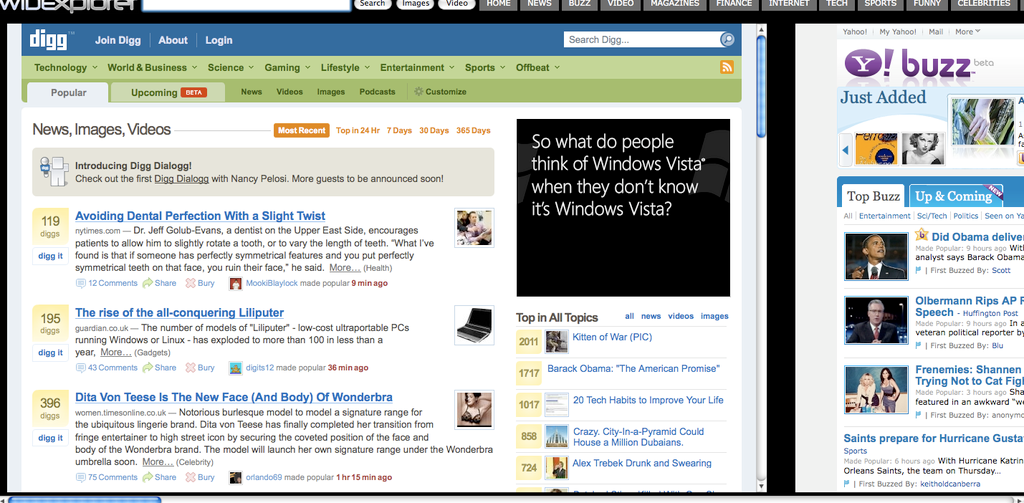
I'm not usually one for lolspeak, but OMG, this site is cool. Rather than having multiple tabs (or, heaven forbid, windows) open to visit different sites, now you can navigate them all on one page. Widexplorer aggregates content from dozens of the web's top sites, like digg, YouTube, TechCrunch, and more. You scroll horizontally to see more sites, and each site is also scrollable vertically. The awesomeness is overwhelming.
Keep reading...
Wednesday, August 27, 2008
The Facebook Friendship
It’s not news that Facebook has transformed the way we think of friendship. Essentially, it allows tenuous relationships to be revived, and survive once lethal obstacles to keeping in touch, such as moving away after high school or college. During the four years I have been on Facebook, numerous correspondences have sprung up with people I would otherwise have not been in touch with once our lives diverged. Geographical distance once made keeping up so-called “weak-tie” relationships quite difficult, as people generally did not take the time to call or write letters. People become busy with new relationships as they move through life, and the weaker ones of their past fall to the wayside.
Facebook, however, has made contacting old acquaintances easy—perhaps too easy. People (myself absolutely included) are notoriously bad at responding promptly to Facebook messages. Although they have largely taken the place of email for friend-to-friend communication, they still do not have the urgency that email can have. It seems people strike up conversations on a whim, and may not be ready when a short “What’s up” turns into a lengthy e-epistle.
My inbox is filled with conversations that started off strong, with myself and the other person trading messages regularly for days or even weeks, but which gradually dwindled away into nothing. One person fails to respond (likely forgetting, since many of us are deluged with countless messages each week), and the other person never follows up. I have experienced this with dozens of different people, but I don’t think either person is really to blame. Most of us do not have the time in our lives to devote to more than a handful of personal correspondences.
For some, this is where blogging comes in; it allows us to keep a mass audience informed of our activities, but saves the time of telling each person separately. Unfortunately, blogging is inherently not as personal as a message, so there is even less pressure for the intended audience to read it.
In the end, if everyone is on the same page regarding this issue, it doesn't really matter. True friendships will flourish, while ephemeral ones will fade away.
Keep reading...
Monday, August 18, 2008
Sweet NYTimes.com Surprise
I was reading an article on the New York Times website as I've done many times before, when I inadvertently clicked on a random word in the text. Some articles already have hyperlinked words (designated by their blue color), but most do not. However, when you double-click on ANY word in the article, a window pops up offering encyclopedic or linguistic information about that word (or phrase--clicking on the first word of "as well as" gives you a pop-up for that expression). Hovering your mouse or rolling over words provides no hint of this hidden capability. This seems to be almost an easter egg, available only to those who make a mistake.
This function is extremely exciting; no other website offers fully-clickable text. Wikipedia has perhaps only 5% hyperlinked words in its articles, which does not include common words, only encyclopedic ones. The New York Times is showing us the full potential of internet reading: the ability to instantly look up words or concepts we wish to learn more about, while never having to leave the page you're on.
Hats off once again to the Times.
Keep reading...
The Last Days of Telephones

As technology progresses, obsolete objects begin to appear increasingly anachronistic when we encounter them. This is happening now with things like full-size cathode-ray tube computer monitors, VCRs, and portable CD players. But perhaps the most striking and life changing example is the slow disappearance of landline telephones. If you’re in the U.S. and less than 30 years old or so, it’s likely that you rarely, if ever, use a landline phone. What’s more, when my generation has children, the concept of a phone that remains in the house will be totally foreign to them.
The Baby Boomer generation, however, will never give up their familiar landline phones, no matter how redundant they become. There are tens of millions of people who continue to pay for regular phone service, in addition to their mobile plan. Having a stationary phone that is physically connected to their house seems to be comforting in some way; it’s always on, and it always rings loud and clear. Cell phones can be misplaced, get set on silent unintentionally, or run out of batteries. Many Boomers are not accustomed to charging their phones daily, and bring it with them each morning is not as instinctive as it is with younger users.
As landline phones cease to be of use, it will be interesting to see where they end up. Unlike cell phones, they are not desired for donation to third world countries, since these nations never set up a telephone infrastructure in the first place, instead skipping straight to mobile phones. Assuming approximately 100 million households in the United States, and at least two phones per household (not to mention answering machines), we’re looking at around 200,000 tons of electronic waste. I can only hope someone figures out a solution to this byproduct of progress.
Keep reading...
Tuesday, August 12, 2008
Wanadoo City Wows Me

Check out Wanadoo City, a totally immersive role-playing experience for kids in Florida. It seems like the kind of thing that sounds cool in concept, but wouldn't actually work in real life. Lo an behold, it's extremely successful.
Article
Website
Keep reading...
Sunday, August 3, 2008
Sharing Music: A Situation Most Awkward

In one of the most memorable scenes of the movie Garden State, Natalie Portman’s character places her headphones around Zach Braff’s ears, inviting him to listen to a song that will “change [his] life.” Braff complies, and the first few notes of The Shins’ New Slang are heard diagetically by Braff and the audience alike. Most of us have been in Portman’s or Braff’s shoes in our lives, either eagerly sharing a beloved piece of music with a friend or being on the receiving end of such an invitation. In my experience, this exchange ranks highly on the list of most awkward social situations.
To start with, it’s two people, often of the same gender, listening silently to a song for 3-5 minutes. A little weird. But it gets worse. For the sharer, waiting pensively while the song works through the intro, ever so slowly building up to that bit that makes the song awesome, is a nerve-wracking 30-45 seconds. For the sharee, enduring that first third of the song, wondering what in the world makes it so great, is equally difficult. Making this process even more tricky is the pressure-packed nature of the situation, which makes enjoying the song—that is, really listening to it, finding beauty in the lyrics and the music itself—nearly impossible. The sharee can hardly say he doesn’t like it; he’s practically compelled to like it by the enthusiasm of his friend. And the sharer is dying for his friend to confirm his opinion—doubt about his musical taste swells with each second that passes.
I don’t know the solution to this dilemma. One can always recommend that a friend listen to a song on his own time, but there is no guarantee this will actually happen. It’s also possible to start the song and then leave the room, but this might also seem a little strange. Music can be totally social, or intensely personal. In the end, perhaps it’s best just to keep one’s treasured tunes to oneself.
Keep reading...
Sunday Links
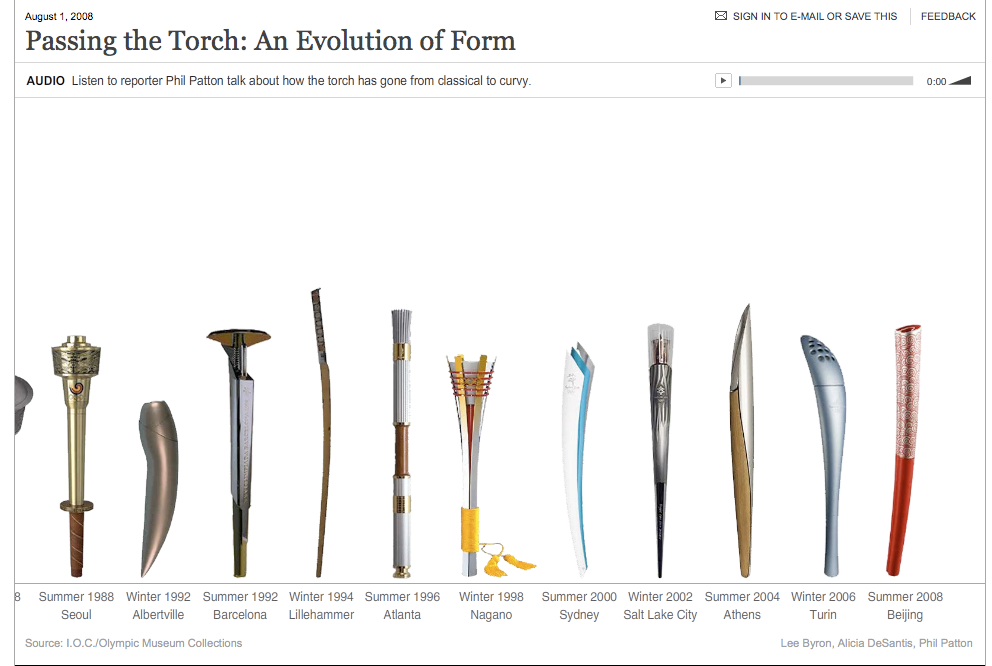
The New York Times has put together an interactive infographic showing the history of Olympic torch design, apparently reading my mind (two months ago I had searched for a book on just such a topic). 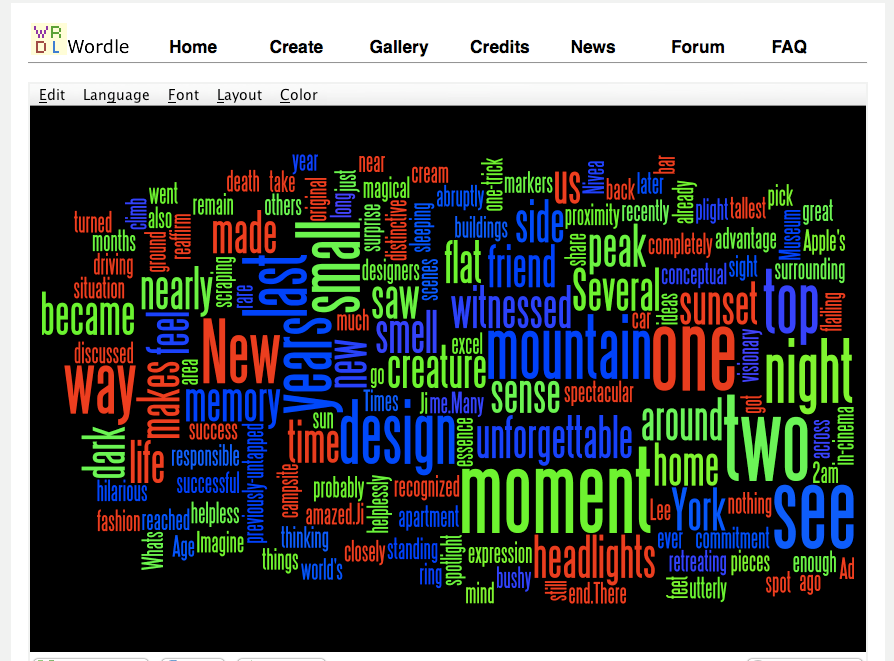
Wordle creates customizable word clouds of whatever text or website you choose.
Keep reading...
Saturday, July 26, 2008
Funny Starburst Commercial
A hilarious new spot from Digitas for Starburst...the acting is excellent, especially the two "Whats" at the end.
Keep reading...
Images I Will Never Forget
There are moments in life that you immediately recognize as "unforgettable," scenes so poignant or upsetting that they remain forever frozen in your mind. Yesterday I experienced just such a moment, and it prompted me to go ahead and share two others that are also eternally etched in my memory.
As I was driving home late last night me headlights suddenly illuminated one of the most disquieting things I have ever witnessed. A small animal, probably a possum or a raccoon, was lying on its side, flailing one arm helplessly in an attempt to right itself. I've never swerved so hard in my life. Though it was dark and the creature was small, I would swear I could see an expression of pure fear on its face, as it recognized its imminent fate. To see such a helpless creature in its death throes, and unable to assist it in any way, was crushing to me. And the fact that my headlights served as a sort of spotlight on its pitiful plight made it even more unforgettable. 
The second moment, retreating back in time chronologically, occurred last summer. I was on a two-month UGA-sponsored trip out west to learn about the human and environmental history of the region. One night, while in Colorado, a few of us decided to climb the modest peak near our campsite. The mountain had no paths or markers, and we were forced to scramble up rockpiles and bushy outcrops, scraping ourselves on brambles and branches as we worked our way through. Time was of the essence, because we wanted to be at the top to see the sunset and still have enough time to get down before it was dark. After about 30 minutes of trailblazing, we reached a clearing. The peak was in sight. We rushed the next few hundred yards, anticipating a great view of the surrounding area. What we got, however, was better than anyone expected.
The opposite side of the mountain abutted an immense, utterly flat plain. Looking down, we saw a sheer drop-off of about 1000 feet. Never before had I been so in awe of Earth. Sublime, it was. Imagine standing on top of one of the world's tallest buildings, and looking out to see nothing but flat land. It makes you feel small, and it makes you feel lucky to be alive. The five of us witnessed the most magical, beautiful sunset of our lives on top of that mountain. A moment from that night has been my Facebook profile picture for nearly a year now.
The last scene is not a pleasant one. Several years ago my girlfriend of over three years cheated on me. This took me completely by surprise; only months before I'd bought her a diamond and gold "promise ring" to reaffirm my commitment to her. Nonetheless, our problems apparently became too much for her to handle, and she abruptly left me. Several days later I went out to a bar with some friends to try to forget about her (something I wasn't able to do for nearly two years). On the way home, around 2am, my friend made a wrong turn. As we turned around, I saw her (extremely distinctive) car parked outside an apartment building. Clearly she was already sleeping over with her new beau. It was in this moment that the finality and brutality of the situation truly became clear to me.
Keep reading...
Ji Lee is Amazing

Many designers are one-trick ponies; they excel at product design (Apple's Jonathan Ive), book design (Chip Kidd), or fashion design (take your pick). Ji Lee is the rare designer who is successful across disciplines. Thanks to my friend Andy Pearson for introducing me to this inspiring visionary. His ideas are conceptual, his thinking original and groundbreaking. He is responsible for various photo-illustrations in the New York Times, a spectacular promotional campaign for the New Museum in New York, and hundreds of other incredibly insightful pieces. Check out his website and prepare to be amazed.
Ji Lee
Keep reading...
Saturday, July 19, 2008
Consumption v. Creation: The Debate Rages On

The ways one can choose to spend his leisure time are many and varied. How one spends these hours can be an insightful indication of one’s personality—drinking, sleeping, watching TV, and exercising are all possible options, and each says something very specific about the person who selects that activity. Exercising for me is essential, and drinking is generally unappealing. Beyond this, I face a fundamental decision about how to enjoy my free time: simply put, I can produce culture or consume it.
Undoubtedly consuming culture is the easier of the two. Watching TV or movies, reading books or magazines, or surfing the web are all ways I might consume the fruits of others’ creative labors. Doing so is entertaining and educational, and gives me new insights into the human condition and my place in the world. But it is also time-consuming, and takes time away from producing content myself. What’s more, to really understand a good piece of art (be it filmed or written), one should experience it multiple times. This is especially true for lengthy and/or intricate works of fiction with several layers of symbolism and metaphor, like the works of Vonnegut, Marquez, and Tolstoy. But to enjoy a work by one of these men more than once is nearly unthinkable; with so much else to discover and accomplish, how can one find the time to really delve into something?
On the other hand, I have aspirations to learn web design and video editing, to start building websites and making short films. I’d also like to write a screenplay, as well as continue refining plans I have for various businesses and products. But what should the balance of these activities be? Producing culture, of course, is not independent of consuming it; indeed, inspiration by definition emerges from the absorption of others’ ideas. Creativity does not exist in a vacuum—it feeds off itself, constantly spawning new variations on old themes. To favor creation over consumption, to ignore the history of human artistic output, is to do a disservice to oneself. You risk repeating trite tropes, as well as miss out on a treasure-trove of inspiration.
Keep reading...
Saturday, July 12, 2008
Trees Shouldn't Be Wasted on These

Despite the big environmental kick the country has been on the past few years, there is one very un-green object whose presence persists, perhaps now more than ever: the bathroom paper towel. Though attempts have been made to reduce individual consumption (pre-perforated sheets of a smaller size than people are otherwise inclined to take), still no limit has been placed on the total amount it is possible to use. Many times I have witnessed men yanking a spool of sheets off the roll, rubbing the paper lightly on their hands, then crunching the barely-used paper into an approximation of a ball and tossing it in the garbage. I have also often seen stacks of unused paper towels on the floor or in the wastebasket after being unintentionally pulled out of their case; these are undoubtedly sent to the landfill without ever being used.
I generally abstain from paper towel usage altogether (instead shaking most of the water off and then matting my hands down on my pants or the back of my shirt), and if I do use them, I take as little as possible. The rate at which paper towels accumulate at my office is absurd; to extrapolate this out means multiplying my office by all the offices in my building, all the buildings in Atlanta, ad nauseum. That’s tons of paper being discarded daily after only a gentle moistening. At least toilet paper and napkins gets dirty; I’m certainly not claiming there is any replacement for them. But the alternatives to paper towels are many and superior.
If conserving resources and saving trees is actually important to us, we need to begin by cutting back on paper towel consumption. To continue to be so blatantly wasteful is inexcusable.
Keep reading...
Wednesday, July 9, 2008
More Walking Problems
This morning I reached the elevator in the parking deck at nearly the same time as a middle-aged woman, whom I do not know. When the elevator arrived, I let her enter first, according to the principle of “ladies first.” After doing so, however, I had second thoughts. Would this woman feel uncomfortable having a young man walk behind her into a sealed box? When the doors opened I faced the same problem, but once again came to the same decision. It seemed rude to exit first, so I let her go ahead. Of course, this had the domino effect of making her the first person to reach the door to exit the building. At this point I was hoping she would stand at the door and hold it in order to let me go ahead, but unfortunately she merely held the door behind her, so that I remained behind. I would have liked to walk quickly ahead to be able to open the next door for her, but doing so surely would have seemed strange and perhaps threatening. So once again the young man had the door opened for him by the middle aged woman. It seemed so backwards, but there was nothing I could do. We finally reached the elevator inside the office building together, and shared a short, but still awkward ride several floors up.
What should I have done????
Keep reading...
Independence Day Thoughts

On Independence Day I ran my first 10K, the Peachtree Road Race in Atlanta. The Peachtree lays claim to the title of the world’s largest 10K, with over 55,000 runners. I hadn’t really trained for the race, but I finished with a respectable time of 50:50, about two minutes faster than the only other time I’d run 6.2 miles. A company called MarathonPhoto deploys an army of photographers to a bridge over the road, each of whom takes a continuous staccato-stream of snapshots of exhausted runners crossing the finish line. As the runners leave the race site they are beckoned to the MarathonPhoto area to view their photographs and, it is hoped, purchase a memento of the occasion.
I’ve never been one to display pictures of myself, so I didn't even consider looking at my pictures. So imagine my surprise when I received an email today from MarathonPhoto, inviting me to review my raceday photos. The company managed to not only get three reasonably in-focus shots of me, but within a week were able to use my race number to track me down and send me an email. I have to assume this process is done manually, for each of the 50,000+ runners in the race. The efficiency of their system boggles my mind.
Overall, the race experience was fantastic—there’s no better way to start to this historic day than joining my fellow Atlantans to run down the city’s most famous street. You wake up, run, cook out and relax, then come back together to watch one of several amazing fireworks shows around the city. It’s a universal holiday, enjoyed by young and old, families and couples alike. Even the most jaded among us can appreciate the patriotic colors and songs and take part in the festivities.
My only concern (recently provoked by a coworker) is that referring to the holiday as “the fourth” detracts from the gravity of the day, and contributes to its slow loss of context and meaning. (I’m also concerned that the day will soon become known as “Will Smith Movie Day” due to his annual appearance in a blockbuster film released before the holiday.) I pledge to always refer to it using its appropriate, government-designated name in the future, and I encourage everyone else to do the same.
Keep reading...
Friday, June 27, 2008
A Super Store, Indeed

If Augusta National is golf heaven, then the PGA Superstore is heaven’s pro shop. Having grown up amidst a retail wasteland, it’s rare that . But when you enter a store dedicated to two sports (about 90% golf/10% tennis) and find yourself in a cavernous room whose size rivals stores with much broader inventories like Costco and Sports Authority, it’s hard to stay composed. As excited as it was for me, the casual duffer that I am, I can only imagine the childish glee a dedicated golfer feels as his eyes feast upon the treasure before him.
It’s literally mentally challenging to take in everything at once, to come to grips with the fact that this store’s putter department is the size of a typical sports store’s entire golf section. The staff , though knowledgeable, is not pushy. Buyers (or, rather, visitors) are free to roam and gawk without being coaxed into a purchase.
One whole wall of the store is lined with practice cages, half for private lessons and half for testing out equipment. Indeed, the PGA store takes all the guesswork out of buying a club; in front of the cages are hundreds of demo models of the latest drivers, all available to try out for free, and without the need to surrender a driver’s license or sign forms in advance.
The store carries not only every conceivable piece of golf equipment and attire, but also a full range of golf gifts for the true aficionado (golf art is a genre sui generis, with gaudy brushstrokes of various shades of green and yellow, often seen adorning the walls of dentists’ waiting areas).
While the store’s name may suggest otherwise, the other prime country club sport is nearly as well represented. A full-size indoor tennis court is located in the back of the store, replete with hundreds of demo rackets, as well as fresh white shoes to wear while serving.
The sports equipment business is a competitive one, with craigslist, eBay, and other online retailers only exacerbating the need for cutthroat pricing and regular discounts. The PGA Superstore, however, offers an experience unlike anything else in the city, no doubt earning the affection and loyalty of its customers, many of whom are likely some of the wealthiest citizens of Atlanta. It lives up to its name in every sense of the word.
Keep reading...
Saturday, June 21, 2008
The amazing box
There is no shortage of things to be amazed by in this world. Flight, pi, and air conditioning are three that readily come to mind. And yet despite the myriad miraculous things that we encounter throughout our lives, there is one object that is sorely neglected.
The box.
Not the “Box,” as in the large metal shipping containers used for intermodal freight transport (seen on ships, freight trains, and 18-wheelers), but the humble cardboard box. Of course there is the basic and boring 12-panel box, widely used for personal shipping purposes. But box technology has advanced far beyond that. Many templates, such as the one seen above, are incredibly complicated. These rely on intricate, origami-like folding and tucking, and often use glue to hold reinforced layers together. This results in boxes with a variety of compartments and closures. Some are as sturdy as metal or plastic boxes, which, when one remembers they’re made of paper, is pretty impressive.
Clearly these complex plans are the result of expert design, based on specific guidelines for their eventual use (display, shipping, storage, etc.) Someone is being paid to constantly devise new box designs, pushing the limits of container creativity. Indeed, determining how various pieces should be cut, folded, perforated, etc. is no easy task. This person must have superior spatial-reasoning skills—and probably finds great pleasure in those tricky IQ test problems asking which template corresponds to which box.
Not surprisingly, compendiums of box templates exist for would-be packaging designers to gain inspiration and assistance from. To be sure, boxes are big business. Grocery stores accept hundreds of them each day, filled with wine, produce, and a huge range of further-boxed goods. Companies across the world rely on acid-free boxes to store important documents and records. And anyone who has ever moved knows how helpful they are in transporting one’s belongings.
Appreciate the box. It’s one of life’s most inconspicuous heroes.
Keep reading...
Saturday, June 7, 2008
Newspaper Delivery Hero
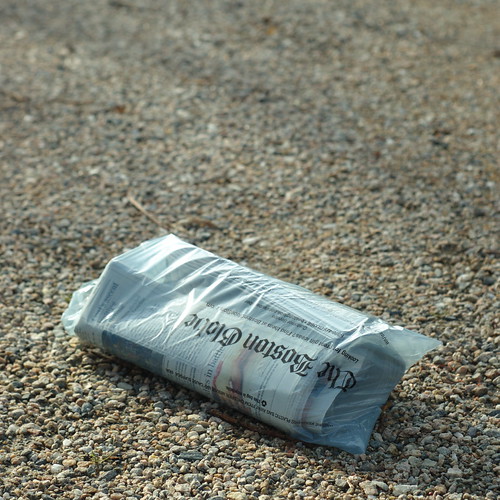
I wake up ridiculously early. Generally it’s between 4am and 4:30am, with remarkable consistency. At this time of night it’s still fully dark and eerily quiet. My habit when rising this early is to prepare a bowl of cereal and enjoy it while reading the newspaper. As in the current day’s newspaper. Now you might say to yourself, “Why, but the previous day just ended four hours before! Surely they’re still working on finalizing the next day’s edition, or at least still printing at such an hour!”
Amazingly, when I walk down the driveway every morning before 4:30, the paper is there. Without fail. (Perhaps an event of historical proportions, such as the upcoming election, will break the streak.) I never cease to be amazed at the efficiency of this process—from articles being written, to edited, to put in a layout, to printed, to loaded in cars, to distributed, all before 95% of Atlantans are awake.
So this is partly a message of thanks to my newspaper delivery person: I don’t know who you are—whether you’re a man or woman, young or old, whether you drive a car or a truck, or if you throw the paper with your right hand or your left. But somehow, despite the obscenely early hour at which I require it, I have freshly printed news every morning. Most people might not appreciate how early you get your job done, but it means the world to me.
Keep reading...
Thursday, June 5, 2008
Another Awesome NY Times Chart
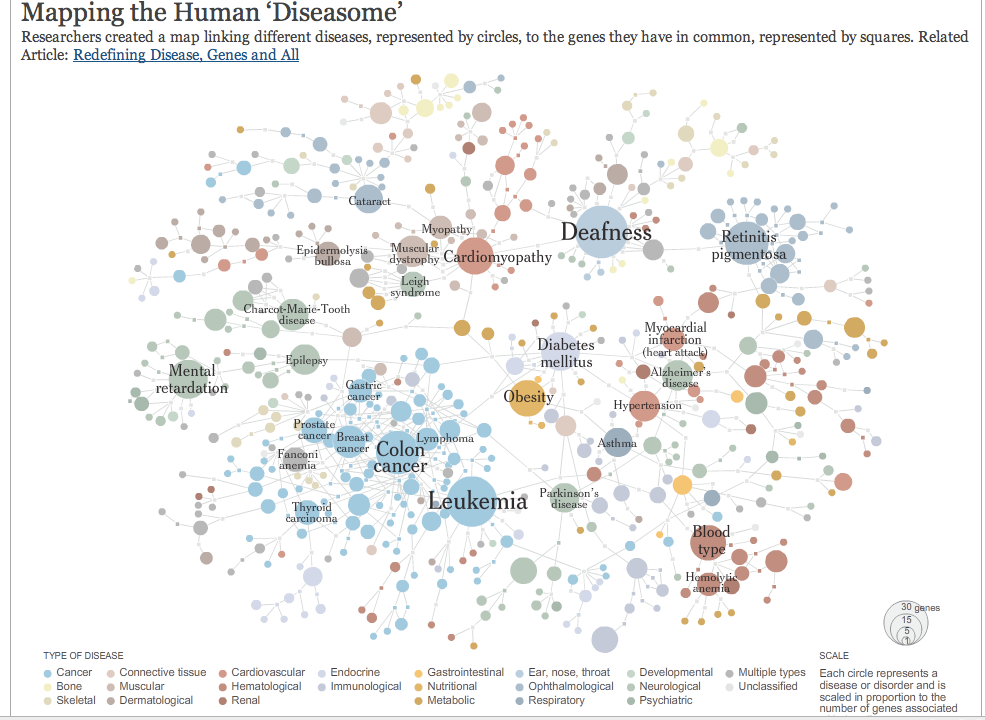
An amazing map of human diseases, sorted by genes that certain diseases share.
Keep reading...


